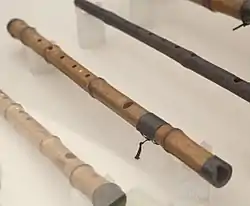Tungso
The tunso (hangul: 퉁소; hanja: 洞簫) (sometimes tonso, transliteration of its Chinese name of dòngxiāo) is a Korean notched, end-blown vertical bamboo flute used in Korean traditional music.[1] It is similar to the danso, but longer and larger.[2]
| Tungso | |
| Hangul | 단소 |
|---|---|
| Hanja | |
| Revised Romanization | tunso, tonso |
| McCune–Reischauer | t'unso, t'onso |

The instrument is parallel to the Chinese xiao, and equivalent to its variant, dongxiao, and the Japanese name is shakuhachi. A distinctive feature of the tungso, unlike other vertical flutes is that it may have a buzzing membrane, similar to that of the Korean transverse flute, the daegeum. This is especially common in the folk variety of the instrument.
The tungso is a vertical flute made of thick, aged bamboo. Until the mid-Joseon Era, tungso had been used mainly in court music, but by the end of the 19th century and the early 20th century, it became a more widely used instrument. Today, it is played in accompaniment to masked dances like the Bukcheong Sajanoreum.
Regarding the instrument's name, tong means "hole" and so refers to the notched end-blown vertical bamboo flute.
See also
References
- "퉁소 (translation: Tongsaw)". Archived from the original on 3 May 2012.
- NCKTPA